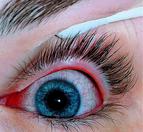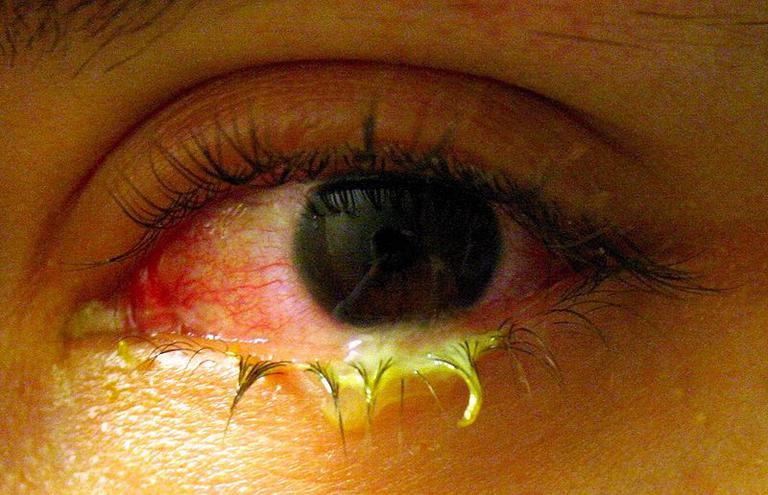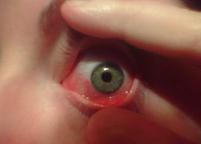 | ||||
Pink Eye Conjunctivitis: Causes & Treatment
How to Determine if You Have a Common Cold or Influenza
from Science Prof Online
Inflammation in the body is an immune response to tissue injury. Swelling of the injured tissue occurs, resulting in pain, heat, and redness as the affected area tries to repair itself.
Any type of tissue can become inflamed, including the conjunctiva, the tissue that lines the eyelid. Conjunctivitis has a number of potential causes, some of which are infectious and include bacteria, protozoans, fungi and viruses.
Article Summary: Conjunctivitis, a.k.a. pink eye, is an inflammation of the mucous membrane surrounding the eye. Here are common causes of and treatments for pink eye.
Causes and Treatment of Pink Eye Conjunctivitis
 | ||||
You have free access to a large collection of materials used in a college-level introductory microbiology course. The Virtual Microbiology Classroom provides a wide range of free educational resources including PowerPoint Lectures, Study Guides, Review Questions and Practice Test Questions.
Page last updated: 5/2014
This article originally appeared on Suite101 online magazine.
SCIENCE PHOTOS
SPO VIRTUAL CLASSROOMS
 | ||||||
SPO is a FREE science education website. Donations are key in helping us provide this resource with fewer ads.
Please help!
(This donation link uses PayPal on a secure connection.)
Common Causes of Infectious Conjunctivitis
Viral Conjunctivitis
Viruses, the most common cause of infectious conjunctivitis, are often associated with an upper respiratory tract infection, cold, or sore throat. Viral conjunctivitis is highly contagious, typically affects one eye, then the other, and easily spreading between individuals. Some examples of viruses that can cause pink eye include Adenoviruses, a group of viruses that cause the common cold and some herpes viruses.
Bacterial Conjunctivitis
Bacteria that most often result in conjunctivitis include the Gram-negative Haemophilus influenzae and Chlamydia trachomatis, one of the leading causes of non-traumatic blindness worldwide; blindness that occurs as a result of conjunctiva inflammation so severe that the eyelashes turn inward, scratching and scarring the cornea. The Gram-negative species that causes gonorrhea, Neisseria gonorrhoeae, can also infect the conjunctiva. Gram-positive bacteria associated with conjunctivitis include Staphylococci, Streptococci. However, there are many types of bacteria that can cause bacterial conjunctivitis.
Bacterial conjunctivitis can last a few days to a few weeks, typically starting with one eye and sometimes spreading to the other. This type of infection usually clears on its own, but antibiotic eye drops may be prescribed.
Allergic Conjunctivitis
The mucous membrane of the eye can also be irritated by environmental substances, such as pollen, dust mites and pet dander in people who are sensitive to these potential allergens. In cases of allergic conjunctivits, both eyes are typically affected. Contact lenses, especially extended wear, can also irritate the conjunctiva.
Preventing the Transmission of Infectious Conjunctivitis
Conjunctivitis caused by microbes is very contagious. Frequent hand washing, and treatment can help prevent the spread of infection.
Treatment of Pink Eye
The body has its own methods of protecting the conjunctiva. Blinking and tears help remove debris that could irritate the eye and also help wash away bacteria. Additionally, the fluid bathing the eyes contains enzymes and antibodies that naturally kill bacteria.
Treatment of infectious conjunctivitis depends on the cause. Viral conjunctivitis does not have a treatment that will eliminate the virus, but is typically mild and usually clears within a week or two. Antibiotic eye drops, ointments or pills may be prescribed to treat bacterial conjunctivitis, and may sometimes be used in cases of viral conjunctivitis, as a preventative to bacterial infection.
Conjunctivitis caused by allergies may resolve with allergy treatment, or disappear on its own when the allergen causing the inflammation is no longer present in the environment (such as with seasonal allergies).
The discomfort of conjunctivitis can be eased by applying a clean cloth soaked in warm water to closed eyes.
Sources
Bauman, R. (2012) “Microbiology with Diseases by Body System,” Benjamin Cummings.
Medscape Reference (2014) Bacterial Conjunctivitis: Overview.
WebMD (2011) Pink Eye: Overview. Healthwise, Inc.
Allergic conjunctivitis.
An eye with bacterial conjunctivitis. Note yellow discharge.





